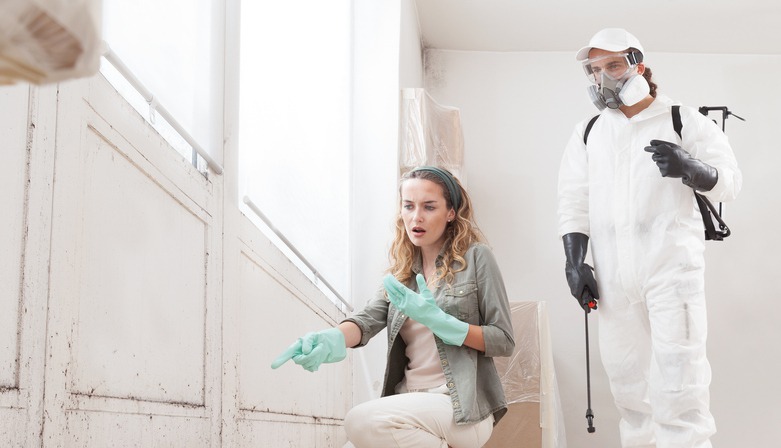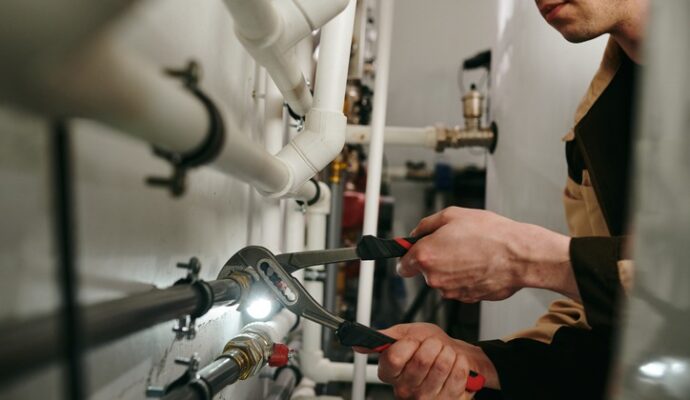Have you ever noticed a musty smell in your home or seen mysterious spots on your walls or ceiling? If so, there’s a good chance you’ve encountered mold. This quiet invader often goes unnoticed, thriving out of sight behind walls, under sinks, or even inside HVAC systems. While a little mold may seem harmless, undetected mold can have a huge impact on your health and your home’s structural integrity.
Every homeowner must understand the health risks of undetected mold and how professional remediation can help. Let’s break down the realities of hidden mold, the signs you shouldn’t ignore, and how industry experts can protect your property and your well-being.
What is Mold and Why Does it Grow?
Mold is a type of fungus that exists virtually everywhere, both indoors and outdoors. The spores are invisible to the naked eye and float through the air, ready to settle and grow wherever they find moisture and organic material. Common places include damp basements, leaky roofs, and areas with recent water damage.
Why is Mold a Problem in Homes?
-
It damages building materials (drywall, insulation, wood, etc.)
-
It degrades indoor air quality
-
It can spoil belongings (furniture, books, clothes)
However, the most pressing concern is its serious health impact, especially when growth goes undetected for long periods.
Common Places Mold Hides in Your House
You might imagine mold is easy to spot, but it’s sneaky. Some of its favorite places to hide include:
-
Behind wallpaper or drywall
-
Under carpets or pads
-
Inside the walls near the pipes
-
Attics and crawlspaces
-
HVAC ducts
-
Basements and below-grade rooms
Regular cleaning won’t always reveal these hidden colonies, which continue to release spores and toxins into your living spaces.
How Undetected Mold Can Affect Your Health
The true impact of undetected mold is on your health. Depending on the type, amount, and location of mold, symptoms can range from subtle to severe, and not all people are affected equally.
Short-Term Health Effects
-
Allergic reactions such as sneezing, red eyes, skin rashes, and a runny nose
-
Worsening of asthma or respiratory discomfort
-
Itchy throat and persistent cough
-
Sinus congestion and headaches
Long-Term Health Risks
-
Ongoing exposure may weaken the immune system.
-
Increased risk of respiratory infections, especially in children and the elderly
-
Consistent exposure to mycotoxins (toxic components produced by certain molds) can result in neurological issues, chronic fatigue, and even cognitive impairment.
People with pre-existing health problems, allergies, asthma, or weakened immune systems are even more at risk when exposed to mold for extended periods.
Who’s Most at Risk from Mold Exposure?
Some individuals are more sensitive to mold than others. Here’s who should be especially alert:
-
Babies and young children
-
Seniors
-
People with chronic respiratory conditions or asthma
-
Individuals with weakened immune systems (for example, due to chemotherapy, HIV, or organ transplant medication)
-
Pregnant women
Symptoms might initially seem like a stubborn cold or persistent allergies, but if the symptoms disappear when you leave your home, mold may be to blame.
Why Mold is So Hard to Detect
Mold is a master of disguise. Small patches may appear in visible places, but large colonies often stay out of sight until serious damage occurs. Why is it so tricky to catch?
-
Many types of mold don’t produce a strong odor.
-
Mold thrives in dark, hard-to-reach places.
-
Structural materials (like drywall) absorb moisture, enabling mold to grow inside walls unnoticed.
Surprisingly, even newly built or immaculately clean homes can harbor hidden mold. Just one unnoticed leak or persistent humidity is enough to let this fungus take hold.
Signs Your Home May Have a Mold Problem
Although undetected mold is, by definition, difficult to spot, there are warning signs every homeowner should note:
-
Persistent musty odors even after cleaning
-
Visible dark or colored spots on walls, ceilings, or windowsills
-
Recent water damage from leaks, flooding, or high humidity
-
Unexplained or recurring allergic symptoms among household members
-
Warped walls, peeling paint, or suspicious staining
If you notice any of these indicators, it’s time to take action before the problem gets worse.
DIY Mold Removal vs. Professional Intervention
With so many cleaning products advertised as “mold killers,” it’s tempting to tackle the problem yourself. However, DIY cleanups can do more harm than good, especially when the problem is bigger than it appears on the surface.
Limitations of DIY Mold Removal
-
Homeowners may not address the root moisture source, leading to recurring growth.
-
Disturbing mold without proper containment or protective gear can spread spores and worsen the problem.
-
Inadequate cleaning allows mold to regrow.
-
You risk missing hidden colonies inside walls or air ducts.
The Value of Professional Mold Remediation
Certified professionals take a comprehensive approach that includes:
-
Thorough inspection and moisture detection
-
Containment to prevent spore spread during cleanup
-
HEPA filtration and air purification
-
Safe removal of contaminated materials
-
Addressing the underlying cause (fixing leaks, improving ventilation)
-
Final inspection and testing to ensure complete remediation
This expert-driven process not only removes current mold but also protects your home from future outbreaks.
The Mold Remediation Process Explained
What can you expect when you bring in a professional for mold remediation? Here’s a simple breakdown:
-
Assessment: Specialists inspect your home, identify growing colonies, and measure moisture levels.
-
Containment: Technicians install barriers and negative air pressure to keep spores from spreading during cleanup.
-
Removal: Infested materials are carefully removed and disposed of. Surfaces are scrubbed and sanitized with EPA-approved solutions.
-
Drying and Dehumidification: The area is professionally dried, and any remaining moisture problems are addressed.
-
Restoration: Damaged drywall, insulation, or flooring may be repaired or replaced as needed.
-
Final Testing: Air quality tests or surface samples verify that your space is safe and free from harmful mold levels.
These steps are crucial for a thorough cleanup that keeps your property and health secure without the risk of hidden surprises down the road.
How Professional Mold Inspections Identify Hidden Dangers
When you suspect mold but can’t find it yourself, a professional inspection uses specialized tools and expertise to uncover hidden issues that ordinary DIY methods can’t touch.
Tools and Techniques for Thorough Inspection
-
Infrared cameras to spot hidden moisture behind walls
-
Humidity and moisture meters
-
Air sampling to detect invisible mold spores
-
Surface swab analysis for precise identification
Expert inspections come with a detailed report and recommendations, which can guide safe and effective treatment before small problems turn into big headaches.
When to Consider Professional Mold Testing
If you recently experienced a water leak, or if you, your family, or your pets are suffering from unexplained allergies, a mold inspection is a wise precaution. Even if you don’t see visible growth, professionals can catch problems early, keeping your home and loved ones safe.
If you’re searching for reliable mold testing in Colleyville, TX, look for local specialists with a great track record, positive reviews, and the right certifications to handle complex cases. Don’t settle for a quick visual check—thorough testing provides peace of mind and clear next steps if mold is found.
What to Expect from the Experts
Partnering with professionals isn’t just about handling crises—it’s about investing in your long-term health and safeguarding your home’s value.
Key Benefits of Working with Certified Pros
-
Reduced risk of mistakes that can make mold problems worse or more expensive
-
Peace of mind knowing every affected area is treated, not just what you can see.
-
Independent confirmation that cleanup is complete (through air or surface testing)
-
Advice on preventing future outbreaks and maintaining healthy indoor air
If you want to learn more about the steps involved, homeowner responsibilities, or general tips, you can often click here for more on reputable industry websites or local government resources.
Additional Steps You Can Take for a Safe and Healthy Home
While professional intervention is crucial for large or hidden infestations, you can stay ahead of the problem with these practical tips:
-
Check your roof and gutters for leaks every season
-
Clear condensation from windows and sliding doors regularly
-
Use exhaust fans in the kitchen and bathroom
-
Store items off the basement and garage floors
-
Avoid carpeting in damp areas like basements
By adding these tasks to your home maintenance routine, you’ll help ensure your home’s safety and reduce the chances of a major mold problem taking root again.
Final Thoughts
Undetected mold isn’t just a cosmetic nuisance—it’s a genuine risk to the health and comfort of everyone under your roof. From persistent allergies to more severe medical complications, taking the threat seriously is the first step toward a healthier, happier home.
If you have a mold issue, don’t wait. Seeking professional help now can save money and stress and ensure lasting peace of mind. Stay proactive, stay informed, and make mold prevention a regular part of your home care routine—it’s the best way to protect the people and places you love.




